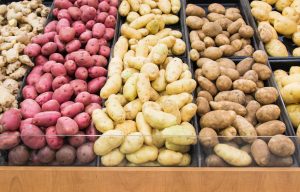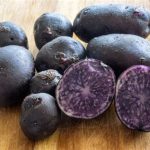The humble potato is a starchy root vegetable with wild beginnings in the mountains of South America. Today, it has spread across the world to more than 5,000 different varieties, 3,000 in the Andes Mountains alone. They spread from there into North America where natives began cultivating them into a staple crop along with corn, rice and wheat. The Spanish Conquistadores took the potato to Europe where it became a big hit and is now a staple crop in many countries.
Through all the selective breeding that has occurred over the centuries, potato varieties generally fall into five groups. All are based on the color of the skin. Sweet potatoes are from a different kind of plant and are not included in any of these categories. The categories are the common red, the fluffy russet, Yukons or gold potatoes, purple and the less common white. Each has different characteristics that make them better for some applications than others.
Also, potatoes can be differentiated by their waxiness. Waxy potatoes seem to hold together better when cooked, making them good for things like soups and potato salad. More mealy potatoes, like russets, are good for baking and frying. Fingerling, creamers, and new potatoes are just immature versions of the full-grown versions.
One of the good things about potatoes is they are very versatile. They can be boiled, roasted, mashed, steamed or baked. Welcome now to Everything You Wanted to Know About Potatoes But Were Afraid to Ask.
Russet Potatoes
Most of the potatoes grown in the U.S. are russets. Also known as Idahos, Bakers, or Burbank potatoes, it’s what most people think of when we say the word “potato.” These have mildly rough brown skin that is fairly thick. When cooked, the inner flesh becomes light and fluffy. If the skin is well washed, it can be eaten too and has a chewy texture when cooked. Many people say the potatoes taste better with the skin on. Also, it contains some important nutrients and fiber.
Warning: Do not eat the skin or eyes of a green potato. If you peel them you should be fine but many people throw them away. Remember potatoes are a member of the Deadly Nightshade family. So, like tomatoes, don’t eat the stems or leaves of the plant. Green tinting in the skin means the potato has been stored under too much light, causing the potato to begin producing a toxin in their skin and then flesh. It probably won’t kill you, but you could get very sick.
These varieties of potatoes are best when the fluffy flesh can be showcased. Russets are best for roasting and baking and mashing, although not the best for mashing in my opinion.
Red Potatoes
These are some of the waxiest potatoes with a bright white interior and thin reddish-brown skin. Many recipes will cook them with the skin on, but once cooked are likely to be easily peeled away. The rest of the potato tends to hold its shape after cooking. These are also called red bliss and redskin potatoes.
Yellow Potatoes
Also called gold or golden potatoes, they are one of the most popular potato varieties. They have a buttery flavor and velvety smooth interior which is, to me, perfect for great mashed potatoes. They can also be fried, roasted or boiled. The skin is thin but when fried or roasted turns crispy. This category included the branded yellow potato called “Yukon Golds,” which has been developed with lower starch content.
White Potatoes
Sometimes called Irish Whites, they are similar in taste and texture to russets. They have much thinner skin that doesn’t usually have to be peeled. The skin becomes very soft while cooking. These are good for just about any cooking method. These are more common in Europe and Australia.
Purple Potatoes
These don’t usually stay long in the Produce section of the grocery store. Not only are they produced less, but they really stand out on the shelf. The skin is usually a little rough and dark violet color. Inside, the flesh is pale lavender. They have an earthy taste and a mealy texture with lots of starch. These are not good for mashing because of the high starch content, it would turn into a paste. But they are great baked, roasted or boiled.
Fingerling Potatoes
Named for their shape and size, they are usually two to four inches long. They have thin skin and a waxy texture that’s sometimes streaked with color. They come in a variety of colors. A great way to prepare them is the wash them well, cut them in half sideways if they’re big, then pan fry them with a little salt, pepper and garlic powder. Roasting or baking is also good if tossed in olive oil and herbs. Fingerlings are a variety of their larger cousins.
Creamer Potatoes
These are also called Petites or baby potatoes or “B” size. They are miniature versions of the larger varieties. These are great for steaming, roasting or boiling.
Sweet Potatoes
These are not actually potatoes even if they look similar and are in the same section of the produce department. Sweet potatoes are in the morning glory family. Unlike the “white” potatoes, their leaves are edible and are sometimes cooked as greens. Don’t call these “yams,” that’s another vegetable entirely.
F.Y.I.: In North America, the sweet potato is often called a “yam” because it resembles a tuber common in tropical regions around the world. Also called “taro,” the true yams are much larger and are common to West Africa, from where most American slaves were brought to the Americas. The sweet potato grew in more temperate climates but reminded many of the yams that were a staple in their diet in Africa.
They have a reddish-orange skin that’s quite tough, meaning most sweet potato dishes call for peeled vegetables, either before or after cooking. Inside, the flesh is bright orange and creamy and sweet. Sweet potatoes have been found to be very high in nutrients. They can be roasted, baked, or mashed into both sweet and savory dishes.
Does It Matter?
The answer is yes and no. What type of potatoes you use for various dishes is largely a matter of personal preference. Nearly all of them can be cooked in any of the many ways available, but with slightly different results. For example, you might like the softer yellow potatoes for your potato salad or use a fluffy potato instead of a waxy one in your soup because the fluffy one breaks down and thickens the soup.
Ultimately, knowing how different kinds of potatoes behave helps you control the outcome and makes you a more successful cook.











